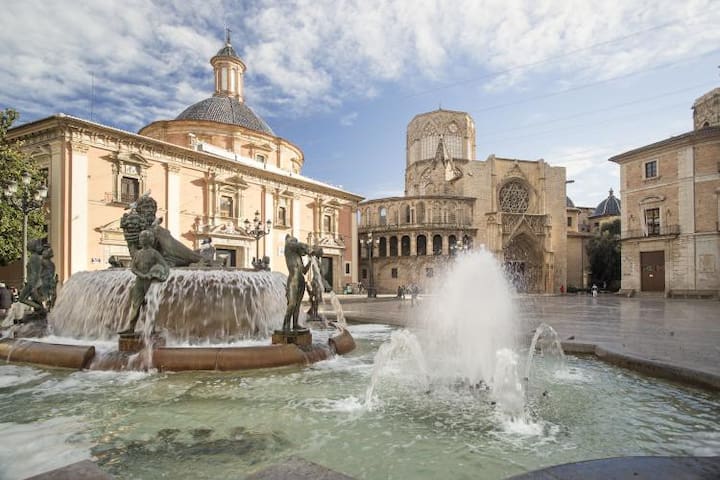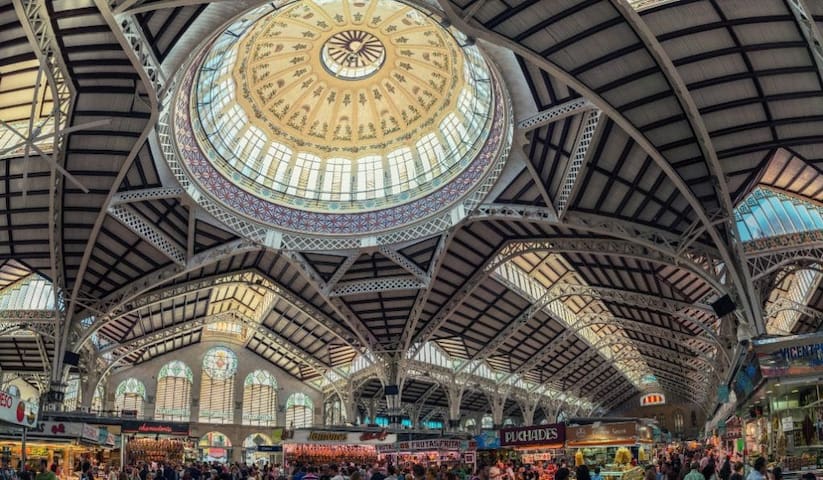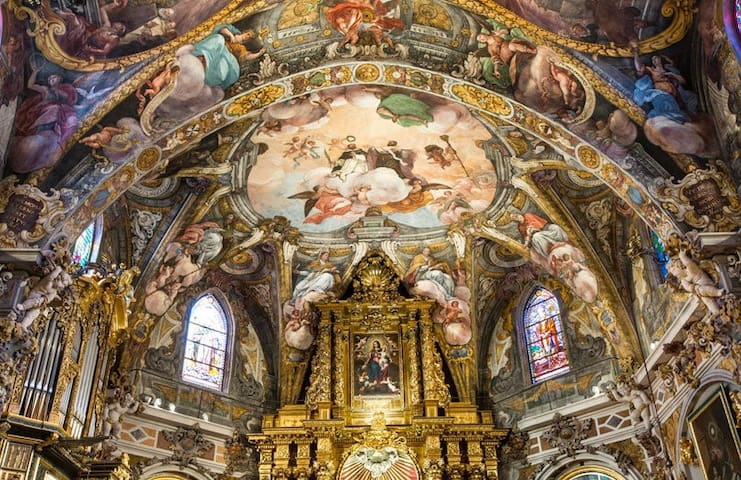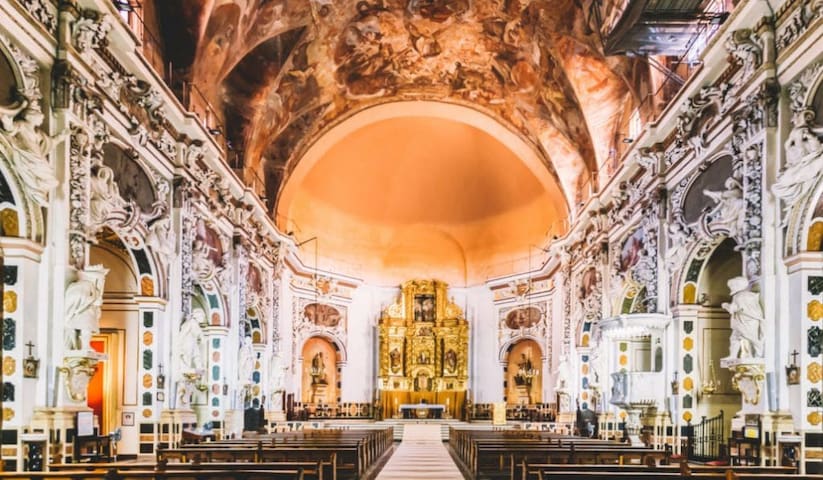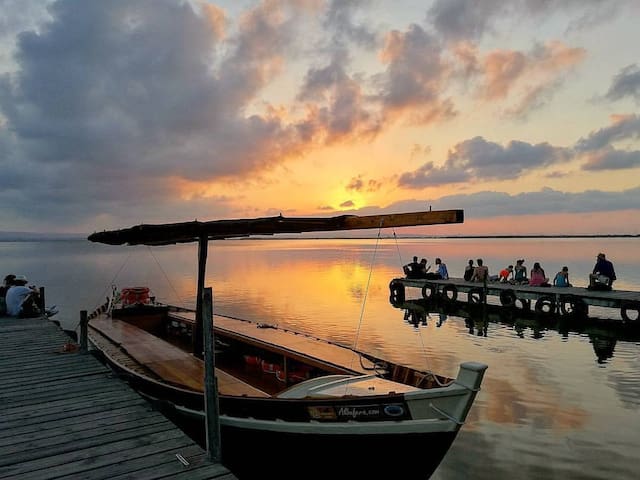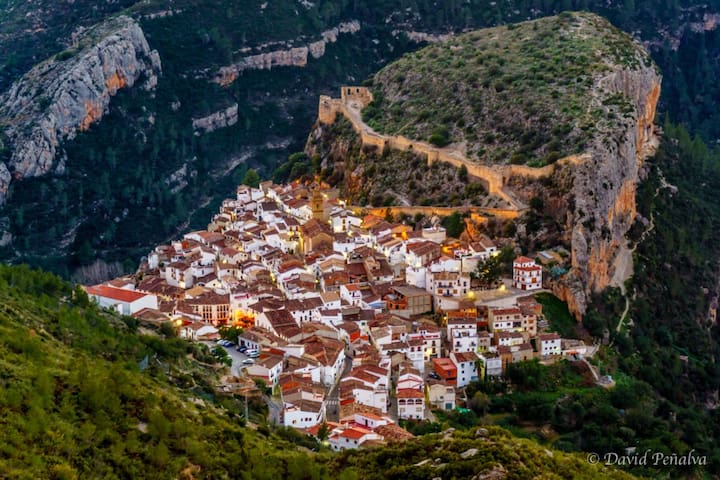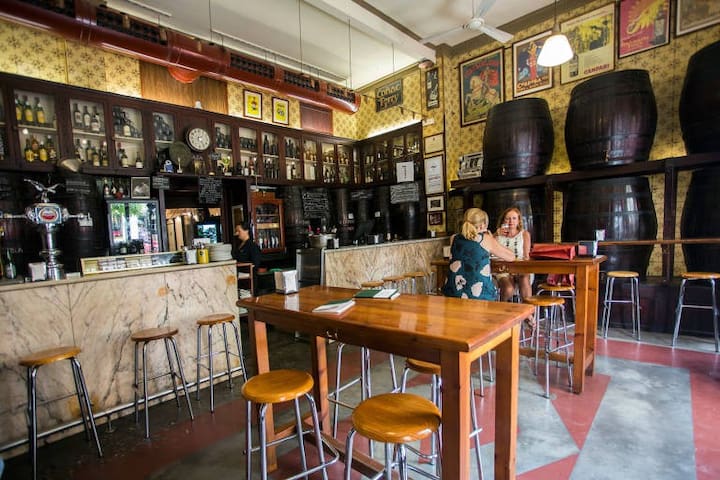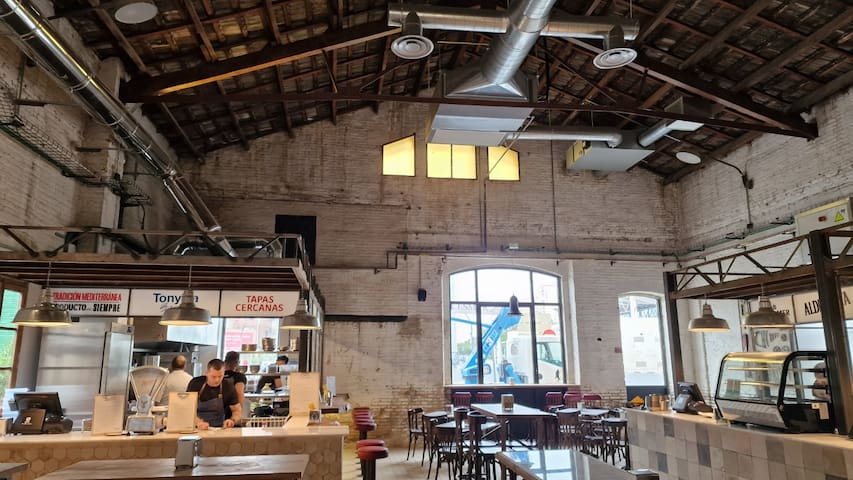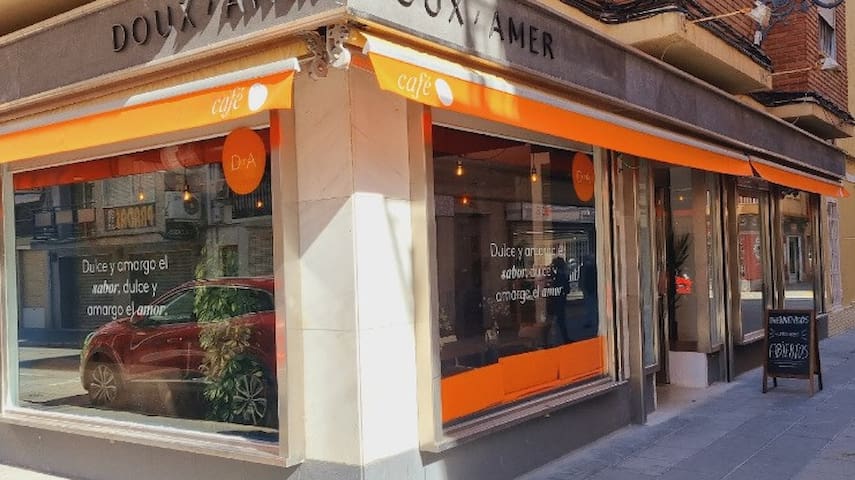Sightseeing
Built on an ancient Roman temple that was later a mosque, the Cathedral of Valencia is a Gothic-style building, although it preserves many elements from different periods, from Romanesque to Baroque eras. Work on the current building began in the 13th century. The Latin cross, the ambulatory and lantern tower over the crossing. In the 15th century, the Chapter house was built (nowadays the Chapel of the Holy Chalice), as well as the lantern tower, the Miguelete door and the Door of the Apostles. Other parts taking the spotlight are the Baroque-style Door of the Irons, and the doors of the Palau or of the Almoina, (Romanesque).
The Cathedral shows both history and art, and is dedicated since the era of Jaume I to the Assumption of Santa Maria. Its walls and doors also protect valuable treasures such as the Holy Chalice. Documentation and archaeological studies lead us to think that the Holy Grail of Valencia is the one used by Jesus in the last supper. The Popes John Paul II and Benedict XVI used this relic when celebrating the Eucharist on their visits to Valencia. It is a cup of polished agate of an oriental origin. Tradition says that, after the last supper, Saint Peter took it to Rome and the Popes who succeeded it kept it there until Saint Sixtus II, who then sent it to Huesca, and during Muslim invasion, the chalice was hidden in the Pyrenees. It was Alfonso the Magnanimous who brought it back to the palace of Valencia. Nowadays it can be seen in the Chapel of the Holy Chalice at the Cathedral.
Another of the Cathedral's treasures is the Renaissance frescoes of the main altar, which were rediscovered ten years ago by removing the Baroque vault that covered them. The paintings were commissioned by Cardinal Rodrigo de Borja, future Pope Alexander V, to the Italian artists Paolo da San Leocadio and Francesco Pagano, who began the work in 1476. 200 years later they were covered in the Baroque reform of the presbytery of the Cathedral. They represent twelve angels playing musical instruments. It is one of the most important pictorial works of the first Spanish Renaissance.
In addition, the Cathedral Museum exhibits up to 90 works of different styles: Gothic, Renaissance, Mannerist. The collection includes pieces by Maella and Goya or panel paintings by Juan de Juanes.
And if you enjoy panoramic views, there is nothing better than climbing the Miguelete tower. You will need to climb 207 steps, but the effort is worth it, since you will get the best panoramic views of the city.
36 місцеві жителі рекомендують
Базиліка Матері Божої Поклитих
s/n Plaça de la VergeBuilt on an ancient Roman temple that was later a mosque, the Cathedral of Valencia is a Gothic-style building, although it preserves many elements from different periods, from Romanesque to Baroque eras. Work on the current building began in the 13th century. The Latin cross, the ambulatory and lantern tower over the crossing. In the 15th century, the Chapter house was built (nowadays the Chapel of the Holy Chalice), as well as the lantern tower, the Miguelete door and the Door of the Apostles. Other parts taking the spotlight are the Baroque-style Door of the Irons, and the doors of the Palau or of the Almoina, (Romanesque).
The Cathedral shows both history and art, and is dedicated since the era of Jaume I to the Assumption of Santa Maria. Its walls and doors also protect valuable treasures such as the Holy Chalice. Documentation and archaeological studies lead us to think that the Holy Grail of Valencia is the one used by Jesus in the last supper. The Popes John Paul II and Benedict XVI used this relic when celebrating the Eucharist on their visits to Valencia. It is a cup of polished agate of an oriental origin. Tradition says that, after the last supper, Saint Peter took it to Rome and the Popes who succeeded it kept it there until Saint Sixtus II, who then sent it to Huesca, and during Muslim invasion, the chalice was hidden in the Pyrenees. It was Alfonso the Magnanimous who brought it back to the palace of Valencia. Nowadays it can be seen in the Chapel of the Holy Chalice at the Cathedral.
Another of the Cathedral's treasures is the Renaissance frescoes of the main altar, which were rediscovered ten years ago by removing the Baroque vault that covered them. The paintings were commissioned by Cardinal Rodrigo de Borja, future Pope Alexander V, to the Italian artists Paolo da San Leocadio and Francesco Pagano, who began the work in 1476. 200 years later they were covered in the Baroque reform of the presbytery of the Cathedral. They represent twelve angels playing musical instruments. It is one of the most important pictorial works of the first Spanish Renaissance.
In addition, the Cathedral Museum exhibits up to 90 works of different styles: Gothic, Renaissance, Mannerist. The collection includes pieces by Maella and Goya or panel paintings by Juan de Juanes.
And if you enjoy panoramic views, there is nothing better than climbing the Miguelete tower. You will need to climb 207 steps, but the effort is worth it, since you will get the best panoramic views of the city.
If you love food, then you will enjoy the fresh produce, their colour and flavour, and if you value richness, variety and quality in the kitchen, then the Central Market in Valencia is a paradise you cannot miss out on. It is an essential place to visit in the city, with an enormous collection of modernist architecture containing fresh produce from the Valencia orchard and all the flavour and aromas from the Mediterranean. Don't doubt about it, visit Central Market. Your senses will thank you!
It is the largest market with fresh produce in Europe and it stands out for its rich and varied cuisine. It is located in one of the most emblematic modernist buildings in the city. It is 8,000 m2 and full of decorative references to the orchard and gardens in Valencia. Its structure, formed by iron columns, remind us of the Eiffel Tower; tile and stained glass make it an attractive architecture that is a must to see. When you visit it, you will not only love what you see, but also the colours, aromas, smells...it is full of Mediterranean life. It is a place where you can buy traditional products, yet it is also a space where more and more tourists visit.
This Valencia agora has more than 1200 stalls with fresh fruit and vegetables, especially oranges, tomatoes and beans. Meat, cheese, spices, nuts, spices fish, seafood are just some of the other products on offer, yet it is the live eels that seem to catch everyone's attention. If you do not want to buy anything, but you want to taste the food, you can stop at the Central Bar, the Central Market's traditional bar at the hands of chef Ricard Camarena, where you can have tapas, assorted dishes and sandwiches. Whether you want to buy products or enjoy the cuisine, the Central Market is a magical place. Don't miss out!
182 місцеві жителі рекомендують
Mercat Central
If you love food, then you will enjoy the fresh produce, their colour and flavour, and if you value richness, variety and quality in the kitchen, then the Central Market in Valencia is a paradise you cannot miss out on. It is an essential place to visit in the city, with an enormous collection of modernist architecture containing fresh produce from the Valencia orchard and all the flavour and aromas from the Mediterranean. Don't doubt about it, visit Central Market. Your senses will thank you!
It is the largest market with fresh produce in Europe and it stands out for its rich and varied cuisine. It is located in one of the most emblematic modernist buildings in the city. It is 8,000 m2 and full of decorative references to the orchard and gardens in Valencia. Its structure, formed by iron columns, remind us of the Eiffel Tower; tile and stained glass make it an attractive architecture that is a must to see. When you visit it, you will not only love what you see, but also the colours, aromas, smells...it is full of Mediterranean life. It is a place where you can buy traditional products, yet it is also a space where more and more tourists visit.
This Valencia agora has more than 1200 stalls with fresh fruit and vegetables, especially oranges, tomatoes and beans. Meat, cheese, spices, nuts, spices fish, seafood are just some of the other products on offer, yet it is the live eels that seem to catch everyone's attention. If you do not want to buy anything, but you want to taste the food, you can stop at the Central Bar, the Central Market's traditional bar at the hands of chef Ricard Camarena, where you can have tapas, assorted dishes and sandwiches. Whether you want to buy products or enjoy the cuisine, the Central Market is a magical place. Don't miss out!
Please, visit this Masterpiece of Renaissance Gothic style. Declared a World Heritage Site by UNESCO.
518 місцеві жителі рекомендують
La Lonja de la Seda
2 Carrer de la LlotjaPlease, visit this Masterpiece of Renaissance Gothic style. Declared a World Heritage Site by UNESCO.
The Church of San Nicolás de Bari and San Pedro Mártir has recently been restored, revealing a pictorial display that experts have called the Valencian "Sistine Chapel". It is amongst the first twelve Christian parish churches in the city of Valencia following the reconquest of Jaume I in 1238. Erected as a parish church around 1242, it was remodelled at the initiative of the Borja family in the Gothic style between 1419 and 1455, with the Gothic rib vault contracting in the central nave. Between 1690 and 1693, the interior was recoated with Baroque decoration and fresco paintings of scenes of the life of San Nicolás de Bari (Saint Nicholas) and San Pedro Mártir (Saint Peter Martyr), designed by Antonio Palomino and painted by Dionis Vidal.
Every Monday the Church of San Nicolás de Bari receives hundreds of visitors who make the “Walks of Saint Nicholas” or Devotion to San Judas Tadeo (Saint Jude Thaddaeus), patron of impossible causes. Its restoration has been classified as "the most important architectural and pictorial-ornamental work ever carried out anywhere in the world due to the scale of the work and the techniques used", and you can now visit the church with or without a guided tour.
67 місцеві жителі рекомендують
Церква святого Миколая та святого Петра Мученика
35 Carrer dels CavallersThe Church of San Nicolás de Bari and San Pedro Mártir has recently been restored, revealing a pictorial display that experts have called the Valencian "Sistine Chapel". It is amongst the first twelve Christian parish churches in the city of Valencia following the reconquest of Jaume I in 1238. Erected as a parish church around 1242, it was remodelled at the initiative of the Borja family in the Gothic style between 1419 and 1455, with the Gothic rib vault contracting in the central nave. Between 1690 and 1693, the interior was recoated with Baroque decoration and fresco paintings of scenes of the life of San Nicolás de Bari (Saint Nicholas) and San Pedro Mártir (Saint Peter Martyr), designed by Antonio Palomino and painted by Dionis Vidal.
Every Monday the Church of San Nicolás de Bari receives hundreds of visitors who make the “Walks of Saint Nicholas” or Devotion to San Judas Tadeo (Saint Jude Thaddaeus), patron of impossible causes. Its restoration has been classified as "the most important architectural and pictorial-ornamental work ever carried out anywhere in the world due to the scale of the work and the techniques used", and you can now visit the church with or without a guided tour.
This church is another example of an ancient mosque atop which, in 1240, a Catholic church was built outside the city walls. Originally a Gothic construction, due to the reconstructions after fires throughout its history, it's had its current Baroque features since the 17th century. Witness to its Gothic past are the unique nave, buttresses and the large covered rose window, known as "the O of St. John", and that, contrary to what one might think, always remained covered. Of note on the outside is the back entrance, a grandiose design that sets up a masterful dialogue with the Central Market and the Silk Exchange. Of particular note are the altarpiece of the Virgen del Rosario and the curious vane, in the shape of an eagle, which tops the triangular bell tower with a clock. It is known as "St. John's sparrow", and legend has it that parents who lived in poverty made their children look up there, taking the chance to abandon them, hoping that they would be taken in by one of the workshops housed in the semi-basements at the foot of the church.
Inside is a set of thirteen plaster statues representing Jacob and the twelve tribes of Israel, popularly nicknamed "els blancs" (the white ones), and the preserved remains of the frescoes painted by Antonio Palomino, a common element in the pictorial imagery of the city.
20 місцеві жителі рекомендують
Iglesia de los Santos Juanes
s/n Plaça del MercatThis church is another example of an ancient mosque atop which, in 1240, a Catholic church was built outside the city walls. Originally a Gothic construction, due to the reconstructions after fires throughout its history, it's had its current Baroque features since the 17th century. Witness to its Gothic past are the unique nave, buttresses and the large covered rose window, known as "the O of St. John", and that, contrary to what one might think, always remained covered. Of note on the outside is the back entrance, a grandiose design that sets up a masterful dialogue with the Central Market and the Silk Exchange. Of particular note are the altarpiece of the Virgen del Rosario and the curious vane, in the shape of an eagle, which tops the triangular bell tower with a clock. It is known as "St. John's sparrow", and legend has it that parents who lived in poverty made their children look up there, taking the chance to abandon them, hoping that they would be taken in by one of the workshops housed in the semi-basements at the foot of the church.
Inside is a set of thirteen plaster statues representing Jacob and the twelve tribes of Israel, popularly nicknamed "els blancs" (the white ones), and the preserved remains of the frescoes painted by Antonio Palomino, a common element in the pictorial imagery of the city.
Here you will understand the complex History of this city that was founded by the Romans in 138 BC.
43 місцеві жителі рекомендують
Музей Алмойна
s/n Plaça de Dècim Juni BrutHere you will understand the complex History of this city that was founded by the Romans in 138 BC.
One of the biggest architectural complex by Santiago Calatrava including a science Museum, an Imax cinema and and Opera House Palace
1235 місцеві жителі рекомендують
Місто мистецтв та науки
7 Av. del Professor López PiñeroOne of the biggest architectural complex by Santiago Calatrava including a science Museum, an Imax cinema and and Opera House Palace
Just 10 km from the city. Nature in its purest form, magical sunsets, boat rides and the chance to disconnect like nowhere else. An urban oasis surrounded by paddy fields and woods: that is what L’Albufera Natural Park means to anyone who is familiar with it. You will definitely want to pay a visit if you’d like to discover the origins of Valencian cuisine. Because what better reason to come than the fact that paella was invented right here? Head over to the town of El Palmar and try their traditional dishes. Sample some all-i-pebre (eel stew flavoured with garlic and pepper) and marinated striped mullet. You’ll experience a new way of understanding food: enjoying it while also learning its origins. Take a walk along one of the six signposted routes through the nature reserve. Discover all the waterfowl and vegetation, live like an authentic local fisherman on Spain’s largest lagoon. You are sure to return.
La albufera de Valencia
Just 10 km from the city. Nature in its purest form, magical sunsets, boat rides and the chance to disconnect like nowhere else. An urban oasis surrounded by paddy fields and woods: that is what L’Albufera Natural Park means to anyone who is familiar with it. You will definitely want to pay a visit if you’d like to discover the origins of Valencian cuisine. Because what better reason to come than the fact that paella was invented right here? Head over to the town of El Palmar and try their traditional dishes. Sample some all-i-pebre (eel stew flavoured with garlic and pepper) and marinated striped mullet. You’ll experience a new way of understanding food: enjoying it while also learning its origins. Take a walk along one of the six signposted routes through the nature reserve. Discover all the waterfowl and vegetation, live like an authentic local fisherman on Spain’s largest lagoon. You are sure to return.
The village of my father's family and one of the most visited villages in Valencian Community. Just 56 km away from the city, it will worth your visit. One of the most international centers of rock climbing activities. Get ready to discover an environment in which you will enjoy with all your senses in which nature, history and adventure are combined. The area of the Los Calderones Municipal Natural Area is formed by the Turia river gorges and adjacent mountains, from the foot of the Loriguilla Reservoir dam to the Valfiguera ravine, covering an area of 538 ha. The Turia river, when it enters Chulilla, has created a deep gorge that crosses the calcareous rock and forms a spectacular canyon, with vertical walls of more than 80 m. tall. Within the area, two characteristic enclaves should be highlighted: "Los Calderones" and "El Charco Azul".
12 місцеві жителі рекомендують
Chulilla
The village of my father's family and one of the most visited villages in Valencian Community. Just 56 km away from the city, it will worth your visit. One of the most international centers of rock climbing activities. Get ready to discover an environment in which you will enjoy with all your senses in which nature, history and adventure are combined. The area of the Los Calderones Municipal Natural Area is formed by the Turia river gorges and adjacent mountains, from the foot of the Loriguilla Reservoir dam to the Valfiguera ravine, covering an area of 538 ha. The Turia river, when it enters Chulilla, has created a deep gorge that crosses the calcareous rock and forms a spectacular canyon, with vertical walls of more than 80 m. tall. Within the area, two characteristic enclaves should be highlighted: "Los Calderones" and "El Charco Azul".
Gastronomía Cabanyal-Canyamelar-Malvarrosa
One of the best restaurants to try the real traditional valencian food including "valencian paella" prepared on traditional way with orange tree firewood.
135 місцеві жителі рекомендують
Casa Carmela
155 Carrer d'Isabel de VillenaOne of the best restaurants to try the real traditional valencian food including "valencian paella" prepared on traditional way with orange tree firewood.
Go and try traditional appetizers from these ancient fishermen neighbourhood called Cabanyal-Canyamelar. A place founded in 1836 and transferred last time to Emiliano García in 1994 to make a high quality restoration place. One of my favourite places.
253 місцеві жителі рекомендують
Casa Montaña
69 Carrer de Josep BenlliureGo and try traditional appetizers from these ancient fishermen neighbourhood called Cabanyal-Canyamelar. A place founded in 1836 and transferred last time to Emiliano García in 1994 to make a high quality restoration place. One of my favourite places.
Anyora is a typical spanish winery located on Vicent Gallart street, in the neighborhood of Canyamelar since 1937. A tribute to the classical dish.
44 місцеві жителі рекомендують
Bodega Anyora
15 Carrer d'en Vicent GallartAnyora is a typical spanish winery located on Vicent Gallart street, in the neighborhood of Canyamelar since 1937. A tribute to the classical dish.
Mercader Cabanyal
Bar Cabanyal
5 Carrer de Martí GrajalesDoux-Amer Café
29 Carrer de Just VilarGood breakfast!!!
Gastronomía Centro
La Salvaora invites us to take a trip back in time through the history of flamenco and a contemporary review of traditional Spanish cuisine. Its walls contain more than 200 images, the entire history of flamenco, from the 19th century to the present day, making it one of the most charming restaurants in the historic center of the city. Its decoration takes us back to the essence of the Spanish taverns of the early 20th century, and perhaps also to the many flamenco clubs that are scattered throughout Spain. One of my favourites restaurants in the Old Town.
14 місцеві жителі рекомендують
La Salvaora
19 Carrer de CalatravaLa Salvaora invites us to take a trip back in time through the history of flamenco and a contemporary review of traditional Spanish cuisine. Its walls contain more than 200 images, the entire history of flamenco, from the 19th century to the present day, making it one of the most charming restaurants in the historic center of the city. Its decoration takes us back to the essence of the Spanish taverns of the early 20th century, and perhaps also to the many flamenco clubs that are scattered throughout Spain. One of my favourites restaurants in the Old Town.
Central Bar
s/n Plaça de la Ciutat de BrugesSophisticated and cozy Moroccan cuisine restaurant serving traditional stews, grilled meats and wines.
22 місцеві жителі рекомендують
Dukala
27 Carrer del Dr. Sanchís BergónSophisticated and cozy Moroccan cuisine restaurant serving traditional stews, grilled meats and wines.
A really good option to try valencian cuisine raised at a high quality level, including, of course a long variety of paellas.
39 місцеві жителі рекомендують
GOYA GALLERY RESTAURANT
3 Carrer de BorrianaA really good option to try valencian cuisine raised at a high quality level, including, of course a long variety of paellas.
One of the best restaurants in town. Specially the upper side with long tables in front of an open kitchen. Modern cuisine.
Karak
9 Carrer del Músic PeydróOne of the best restaurants in town. Specially the upper side with long tables in front of an open kitchen. Modern cuisine.
Brunch Corner - Sant Bult
3 Plaça de Sant BultGood place for breakfast!
A place with more than 125 years where you can try our traditional drink call orxata. Served frozen and also with the option to mix it with fartons, another local speciality. And in Fallas festival they prepare the best buñuelos with chocolate in town.
Orxateria El Collado
13 C/ d'ErcillaA place with more than 125 years where you can try our traditional drink call orxata. Served frozen and also with the option to mix it with fartons, another local speciality. And in Fallas festival they prepare the best buñuelos with chocolate in town.
Baviera
40 Carrer de la CorretgeriaAn old and typical shop for wine and other kind of drinks
Gastronomía Parque Natural L’Albufera
One of my favourite restaurants in Albufera Natural Park to taste traditional valencian cuisine. Located at El Palmar village.
Restaurant Mornell
31 Carrer de Francisco MonleónOne of my favourite restaurants in Albufera Natural Park to taste traditional valencian cuisine. Located at El Palmar village.
Another of my favourite restaurants in Albufera Natural Park to taste traditional valencian cuisine. Located at El Palmar village.
Restaurante La Albufera
Another of my favourite restaurants in Albufera Natural Park to taste traditional valencian cuisine. Located at El Palmar village.
Best bars in town for a real "Tapas" experience
If you really want to discover what "Tapas" means then visit one of this places
Rausell
61 Carrer d'Àngel GuimeràLa Principal
5 Carrer de Polo y PeyrolónBar Ricardo
16 Carrer del Dr. ZamenhofDrinks & Nightlife
One of the best jazz clubs in Spain. Live music! http://www.jimmyglassjazz.net/
55 місцеві жителі рекомендують
Jimmy Glass Jazz Bar
28 C. de BaixOne of the best jazz clubs in Spain. Live music! http://www.jimmyglassjazz.net/
Flamenco Live music! There you can even feel the breath of the artists!!
49 місцеві жителі рекомендують
Café del Duende
62 Carrer del TúriaFlamenco Live music! There you can even feel the breath of the artists!!
Café Infanta
3 Plaça del TossalA very old place to enjoy a drink.
Café Lisboa
9 Plaça del Doctor ColladoCosmopolitan atmosphere. For drinks!
An original bar with baroque decoration. For drinks and coffee. The best "Agua de Valencia" in town!!
99 місцеві жителі рекомендують
Cafe de las Horas
1 Carrer del Comte d'AlmodóvarAn original bar with baroque decoration. For drinks and coffee. The best "Agua de Valencia" in town!!
An ancient Ice factory converted in a space where enjoy a drink and to eat casual food. Live music every week.
171 місцеві жителі рекомендують
La Fabrica de Hielo
37 C. de PaviaAn ancient Ice factory converted in a space where enjoy a drink and to eat casual food. Live music every week.
A jazz club in Malvarrosa neighborhood with live music from Thursday to Saturday and a good selection of cocktails.
Marino Jazz
A jazz club in Malvarrosa neighborhood with live music from Thursday to Saturday and a good selection of cocktails.
From Wednesday to Sunday PALOSANTO Tablao Flamenco offers you every night from 8:30 p.m. to 9:30 p.m. (additional pass in high season 6:30 p.m. to 7:30 p.m.) a show of fusion between the purest and most traditional flamenco to the most modern and avant-garde flamenco. Check out their programming and enjoy this art in its purest form.
Palosanto Tablao Flamenco
From Wednesday to Sunday PALOSANTO Tablao Flamenco offers you every night from 8:30 p.m. to 9:30 p.m. (additional pass in high season 6:30 p.m. to 7:30 p.m.) a show of fusion between the purest and most traditional flamenco to the most modern and avant-garde flamenco. Check out their programming and enjoy this art in its purest form.

